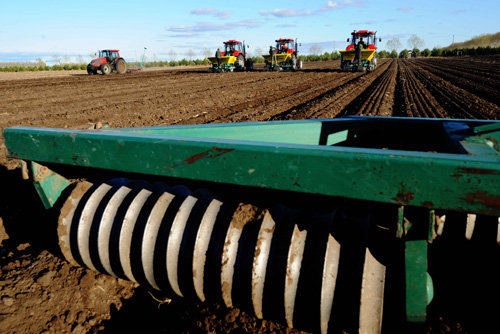|
 |
|
MECHANIZED FARMING: Machines plant seeds at an agricultural cooperative in Keshan County, northeast China's Heilongjiang Province (WANG JIANWEI) |
Seventy-two-year old Eleanor Dvorchak is a typical American farmer with an incredible tie to China: he has twice hosted Chinese Vice President Xi Jinping in his home in Muscatine, Iowa.
Xi first visited Muscatine in 1985 as a provincial official from Iowa's sister province of Hebei. Leading a delegation of four other local officials on an educational trip primarily focused on agriculture, Xi and his colleagues toured local farms and businesses as part of an exchange.
During that tour, Xi spent two nights with the Dvorchaks, who put Xi up in their son's bed.
During the trip, Xi was amazed with America's hi-tech, modern agricultural industry. In China, rural areas were still being farmed by primitive tools like ploughs and sickles.
Today Chinese agriculture has evolved from those simple tools of the past. Major grain-producing areas have realized agricultural mechanization, with technology increasing by leaps and bounds. Better seeds are used to help the country produce more to feed its vast population. Last year, China saw a bumper harvest of grain, with its output rising to a record high of 571.21 million tons, a year-on-year increase of 4.5 percent. The strong harvest marked eight consecutive years of growth for China's grain output.
Even so, China has to face the fact that its agricultural sector falls far short of the United States in several fields.
According to a report released by the China Center for Modernization Research of the Chinese Academy of Sciences on May 13, China's agricultural level is about 100 years behind that of the United States.
He Chuanqi, Director of the China Center for Modernization Research, said that as the world biggest agricultural country, China finds the agricultural sector a drag on the development of its modernization.
Today, improving the rural economy is an important issue China has to deal with.
Why the lag?
The report concludes that despite its high yield of staple grains, China is still hindered by low labor productivity. In 2008, the country's agricultural labor productivity was only 47 percent of the world's average and ranked 91st worldwide.
China's current agricultural labor productivity is around 1 percent of that in the United States, Japan and France, and is even lower than that of Brazil, another emerging country.
The low level may come as a shock, but He is not surprised.
According to He, agricultural modernization usually comprises two phases, with the first characterized by marketization, industrialization and mechanization, and the second by informationization, ecologicalization, diversification and internationalization.
China ranks 75th worldwide in terms of phase one of agricultural modernization, 62nd of phase two of agricultural modernization, and 65th in terms of the comprehensive level, according to the report.
According to He, since China's population is expected to expand to about 1.5 billion by 2050, its demand for grain and meat will increase to 780 million tons and 120 million tons, respectively. In the first half of this century, another 300 million tons of grain and 50 million tons of meat will be needed to feed the entire population. At the same time, a decrease in per-capita arable land will reduce China's agricultural capability.
"Meeting the increasing demand for agricultural produce is both a big opportunity and a challenge for China's agriculture sector," said He.
Different views
Is China's agriculture really that backward? So far, expert opinions vary.
It is not proper to compare two countries' agricultural level simply via statistics, said Huang Jikun, Director of the Center for Chinese Agricultural Policy.
| 